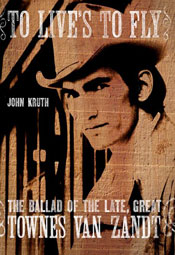
To Live’s to Fly: The Ballad of the Late, Great Townes Van Zandt
by John Kruth
De Capo Press

Cowboy junkie, folk balladeer, lyrical healer, pre-punk performance artist, misfit hellion, yet another self-destructed country star, Townes Van Zandt sure had a knack for eluding definition. Back in the late ’60s, this Texas-born singer-songwriter arose from the ashes of electroshock therapy and his family’s aspirations of a law career to finger-pick exorcisms of soulful torment. Not quite country, folk, or the blues, but a distillation of each form’s emotive poetry, his oeuvre attracted admirers from roots’ more visible ranks, culminating in Willie Nelson and Merle Haggard’s no. 1 recording of Van Zandt’s “Pancho and Lefty.” Other tribute-payers included Emmylou Harris, the Cowboy Junkies, Guy Clark and even Steve Shelley of Sonic Youth, who unsuccessfully tried to squeeze one last album from a dying Van Zandt for the Youth’s Ecstatic Peace label.
For To Live’s to Fly, John Kruth has done a worthy job collecting war stories from the road and the afterparties that starred the livewire Van Zandt. So many outlandish tales fill the pages, you sense there are a hundred more for each one Kruth recounts. Music fans could not ask for a more entertaining character. Of added benefit, Van Zandt’s mixing with such a variety of figures naturally provides a backdoor introduction to the ’70s roots music scene. At times, the high volume of accounts, aggravated by Kruth’s freewheeling narration, pools up around the readers’ eyes; more reading enjoyment might come from intermittent visits as if to a children’s storybook, instead of a straight read-through.
Original interviews with family, friends, tour mates, producers and contemporaries combine with previously culled quotes to decoupage a portrait of someone who resisted being pinned down. Van Zandt’s personality not only reflected this refusal, so did his music, as Kruth reveals in a careful discographical breakdown. Principal actors in this story bicker in a game of he-said/no-but-he-said over why success never materialized for Van Zandt, an interesting study of what helps and hinders artist recognition. Caught on the right night, Van Zandt could hypnotize the most restive dive, but a streak of bad luck (worse than the one that afflicted his gambling habit) designed a series of overproduced albums. Since his death in 1997, only eyewitness reports and live recordings apparently testify to his true greatness.
Van Zandt’s biography has a familiar ring: an artist who sacrificed money, love, family, equilibrium, all life’s normal comforts, for the sake of his art. But he makes the demise of other musical martyrs, such as Phil Ochs or Tim Buckley, seem quick and humane by comparison. After thirty years of hard touring and three failed marriages with children, Prometheus more than Jesus casts the mold for Van Zandt, a man ceaselessly ravaged by substance abuse, endless career disappointments and too many dark nights of the soul. His story recalls the artist’s allegory in the film Basquiat: Suffering from imprisonment, a prince bangs his head against his cell’s bars. But no one who hears comes to rescue him, because the sound of his pain equates the world’s most beautiful music.
Da Capo Press: http://www.dacapopressmusicbooks.com












